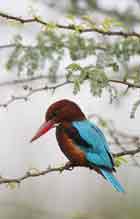Deeporbeel Bird Sanctuary
Deeporbeel Bird Sanctuary is about 18 km from
Guwahati and
covers an area of around 4 sq km. Different types of birds including
adjutant storks, fishing eagle and kingfisher are found here.Since 19th August 2002 Deeporbeel included in the list of Ramsar site for wetlands. It is the only sanctury of Assam which is included in the Ramswar list (Ramsar site no. 1207. Deeporbeel meets the criteria: 1 ,2 ,4 ,7 ,8 of Ramsar site.
Deepor beel is one of the largest and most important permanent freshwater lake in a former channel of the Brahmaputra river, of great biological importance and also essential as the only major storm water storage basin for the city of Guwahati.
In Deeporbeel some of the largest concentrations of aquatic birds in Assam can be seen, especially in winter. The site supports globally threatened birds (IUCN red-listed species) such as the Spot-billed Pelican (Pelecanus philippensis), Baer's Pochard(Aythya baeri), Greater Adjutant Stork(Leptoptilos dubius), Lesser Adjutant Strok (Leptoptilos javanicus), White-bellied Sea Eagle(Haliaeetus leucogaster).
Deepor beel is one of the staging sites on the migratory flyways and some of the largest congregations of aquatic birds in Assam can be seen here, particularly in winter. Highest number of single day count of waterbirds in Deepor beel recorded is 19,000 birds. Deepor beel supports 50 fish species belonging to 19 families. These include high concentration and diversity of indigenous freshwater species. Fish depend on the wetland for food, spawning and nursery.
This wetland is another key site for wintering Ferruginous Duck in Assam. Deepor Beel has been regularly monitored as it the nearest wetland to Guwahati University (ca. 1km away). Ferruginous Duck were mainly recorded between the end of October and mid-March every year.
The 50 fish species present provide livelihoods for a number of surrounding villages, and nymphaea nuts and flowers, as well as ornamental fish, medicinal plants, and seeds of the Giant water lily (Euryale ferox) provide major revenue sources in local markets; orchids of commercial value are found in the neighboring forest.
December to March is ideal to visit the sanctuary. Guwahati Junction Railway Station serves as the nearest railhead.
Photos by courtesy of
Harri Vainola, Ulvila, Finland.





